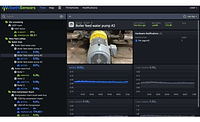While regulators creep closer toward adopting parts of the Food Safety Modernization Act (FSMA), HACCP (Hazard Analysis and Critical Control Points) has taken center stage as food and beverage manufacturers seek the best ways to stay compliant, avoid costly recalls and provide an easier audit experience.
Article Index:
- What's the hold up?
- Is HACCP software the right solution?
- What today's HACCP software can offer
- The benefits of the cloud
Often, the food and beverage companies’ programs are decades old and bogged down by mounds of paperwork and manual recording. One solution to this problem has been to purchase HACCCP software. In short, the software can save food manufacturers from costly recalls and allow them to view the new food safety regulations as an opportunity for improvement through the use of automated data management and task scheduling.
“HACCP planning software offers a framework in which the HACCP principles can be implemented,” says Colin Thurston, project director, informatics, Thermo Fisher Scientific. “The process mapping tools allow the identification of control points and facilitate the establishment of a supporting infrastructure.”
Monitoring the activities of a HACCP program is mandated by regulatory authorities and must be completed by each manufacturer in some form, such as a commercial software package, a customized system, on paper or a hybrid of two or more of these.
But with developments in recent technology, new HACCP software goes beyond these capabilities, offering cloud-based solutions that streamline functionality and provide more options. And, many companies have turned to automated HACCP solutions to be audit ready and able to respond to inquiries, recalls and nonconformance alerts in a timely fashion.
What’s the hold up?
Despite the software’s benefits, everyone who receives HACCP training does so using manual techniques. “It’s really crazy; it’s like teaching accounting with paper ledgers,” says Steven Burton, founder of Burton Software, Inc., which offers a cloud-based HACCP software solution. “People aren’t aware other solutions are available, so they don’t look for them. We have tried to tell manufacturers why it’s important for the food industry, where margins are so tight, and the competitive pressure is enormous.”
According to Burton, developing and implementing a HACCP plan manually can take up to six to eight months, but an automated solution can shrink that time to six to eight weeks.
With the implementation of FSMA on the horizon and heightened consumer concern about where food is sourced, Barbara Levin, senior vice president of marketing for SafetyChain Software, says these factors will cause more companies to seek out HACCP software. “Right now, we are seeing huge adoption of technology to help HACCP programs,” says Levin. “The technology has been used for HACCP in the past, but most of it functioned as document management and track-and-trace systems.” Unlike robust HACCP software, the technology was reactive to recalls, rather than focused on preventing them.
According to Levin, with more software on the market that is preventative in nature, the mainstream adoption of this technology should pour in. “It’s inevitable. If anything needs to be automated, it’s food safety. These automated cloud-based solutions finally give manufacturers anywhere, anytime capabilities,” she says. “They are much more affordable than giant ERP systems, and you get them up and running more quickly.”
Burton, who specializes in building web-based systems for manufacturers, says he stumbled into the food safety industry after discussing a high-profile recall with a manufacturer. “I asked, ‘How do you mitigate the risk occurring from products you produce?’ The manufacturer explained the HACCP system and food safety plan,” recalls Burton. “Then, I was taken to the HACCP coordinator’s cubby, which was lined with paper binders and Excel spreadsheets.”
After some market research, Burton found a ton of software was available, but generally was not being used. He concluded there were two primary reasons food manufacturers were not implementing the software. First, it was mainly an adjunct to an ERP system and too expensive for small and medium-sized manufacturers. Second, much of the available software was antiquated desktop-based solutions that were inadequate for the tasks. These revelations led Burton to begin developing ICICLE HACCP software, an affordable cloud-based system.
Is HACCP software the right solution?
While both Burton and Levin advocate HACCP automation, John Surak, the principal of Surak and Associates, is skeptical about whether HACCP software is worth the expense for food and beverage manufacturers that work within such narrow profit margins.
He says the real issue for any HACCP program is the hazard analysis, and until this can be addressed, software used for nothing more than filling out forms seems to be an unnecessary expense.
Instead of costly software, Surak directs companies to safe and secure online forms that can often be downloaded for free or provides ways for operators to create their own forms. Surak says many of the forms required for a complete HACCP program are easier for operators to fill out manually, and the advanced HACCP software available today does not necessarily make their lives simpler.
Although Surak and others may believe HACCP software is simply a data management tool, Thurston does not. “HACCP is now a way of life for food manufacturers. It is potentially possible to fulfill their needs with paper records, but using these will ultimately constrain their businesses and prevent growth,” says Thurston.
While some solutions specialize in data management, Levin thinks software that is not based will begin to lose footing in the industry.
Before she co-founded SafetyChain, Levin says she was shocked to find that within the areas of food safety and quality assurance, companies were still entering data manually. It wasn’t because food safety managers didn’t want to automate; they were on the plant floor, in the field or at a customer site, not sitting at a desk all day.
What today’s HACCP software can offer
HACCP software can take captured data and make it available anywhere and to anyone who needs it. Food safety employees can carry these applications with them wherever they go on a mobile device. “This software provides the ability to actually automate the management of the program. With it, you can streamline and improve the management of a HACCP plan,” says Levin. “You are audit ready on demand and have up-to-date data at all times for continuous improvement, and that’s made a huge difference.”
Today’s software incorporates data reporting and analytics that can identify trends and potential process issues before they impact a consumer. Thurston says this provides manufacturers with an advantage in terms of cost and brand equity.
For example, Thermo Fisher Scientific offers a version of HACCP software known as a laboratory information management system (LIMS). Its SampleManager LIMS software incorporates workflow configuration tools and integration technologies that allow a company to connect and act on information from the plant and enterprise planning systems as a part of the wider information landscape required by HACCP.
“The majority of HACCP software concentrates on HACCP process management, that is, managing plans, documents and process flows within an organization,” says Thurston. “While this management represents a significant part of HACCP implementation, the ongoing data capture, decision-making and feedback loop associated with the seven HACCP principles also need to be considered.”
According to Thurston, the best way to do this is by creating a HACCP system, which connects data from the LIMS process information management system, for a completely integrated solution.
With the type of system Thurston describes, all the work needed for a particular process is scheduled, and the records for each task are created. In addition, the system tracks all the associated sample results, identifies missing samples and ensures only trained personnel carry out analyses. This software can then publish the results, automatically highlighting those that are out of specification and triggering corrective actions via email. Linking this HACCP data together in the single LIMS, Thurston says, ensures it is accurate, actionable, traceable and auditable.
“The software may have a high ticket price, but in terms of the benefits gained in efficiency, ongoing costs and capacity management, the return on investment for an LIMS is significant. A payback time of less than a year is typical,” says Thurston.
According to Burton, ICICLE software eliminates filling out paperwork related to food safety plans. It also helps identify hazards, provides hazard analysis and prepares the documents. “There are really three parts to the plan: the implementation of the plan through procedures, the supporting evidence through electronic records and incident management,” Burton explains.
“Food company executives struggle every single day with how to get safe, quality products into commerce while remaining profitable and competitive, and I think they are finding out now the answer to that is technology,” Levin says.
Prior to implementing her company’s software, many of SafetyChain’s clients estimated they would need to hire 10 to 12 additional employees over the next three years to keep up with the new regulations. After implementing it, Levin states the clients will likely not have to hire anyone. In fact, they report getting hard dollar ROI within three to six months after going live with SafetyChain’s software.
The benefits of the cloud
Most cloud-based HACCP software does not require local hardware, an IT infrastructure or expertise to run. Many systems can even be monitored on a mobile phone. “That’s a huge advantage for companies that are unable to put in their own data centers,” Burton says. And with cloud-based software, multiple facilities can be managed under the same system. For instance, while process steps under a HACCP program at each facility must be analyzed individually, the food safety analysis of ingredients, materials and packaging can now be shared among different facilities with this software. Other advantages include the ability to grant access to multiple workers and provide access to data from remote locations.
“HACCP software also allows manufacturers to demonstrate to auditors that they have control and traceability within their process by ensuring all the records are available quickly and are linked to relevant data,” says Thurston. “The advantages of an integrated electronic HACCP system become obvious when it is possible to show the link between batch records, quality data, operator training records, release data, microbiology results and so on.”
In Levin’s experience, auditors love these solutions because everything is time and date stamped. This allows third-party auditors with access to set up their own data trends.
Although some manufacturers believe exposing information to multiple operators in the plant could cause security concerns, Levin states there is no fear over security issues within the cloud anymore. “These solutions are roles based, so you can determine who sees what,” she says.
However, the data need not be limited to plant employees or auditors. Forward-thinking companies may opt to open it up to suppliers, so they can find a certificate of analysis or a nonconformance report.
For instance, the ICICLE system is connected to more than 600 facilities and contains about 736,000 products. Each company decides if it wants its products to be made public and available to other clients. This way, when a manufacturer looks to create a formula, it can search the database of public products.
Processors can also discover new opportunities with an effective HACCP system, since major retail chains are requiring higher levels of food safety. “These retailers are tired of waiting for the government to pass more stringent legislation and having their brands and market value damaged because of products they receive from their suppliers,” Levin says. “More retailers are going to demand visibility, and you can’t provide that without technology.”
|
For more information:
Jill Bender, SafetyChain Software, jbender@safetychainsoftware.com, www.safetychain.com
Steven Burton, Burton Software Inc., 604-231-1650, sburton@burtonsoftware.com, www.icicle.burtonsoftware.com
John Surak, Surak and Associates, 864-654-8743, jgsurak@yahoo.com, www.stratecon-intl.com/jsurak.html
Christine Williamson, Thermo Fisher Scientific, 617-275-6528, cwilliamson@greenough.biz, www.thermofisher.com/en/home.html














